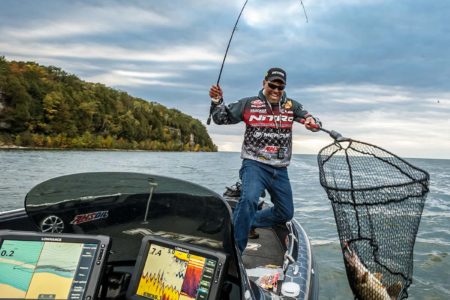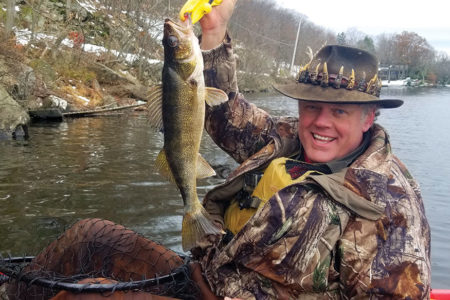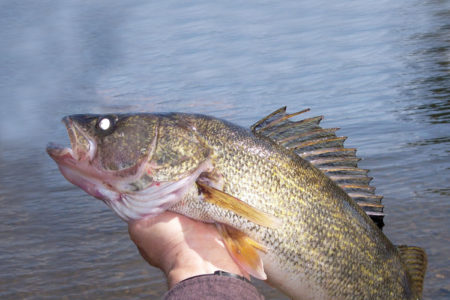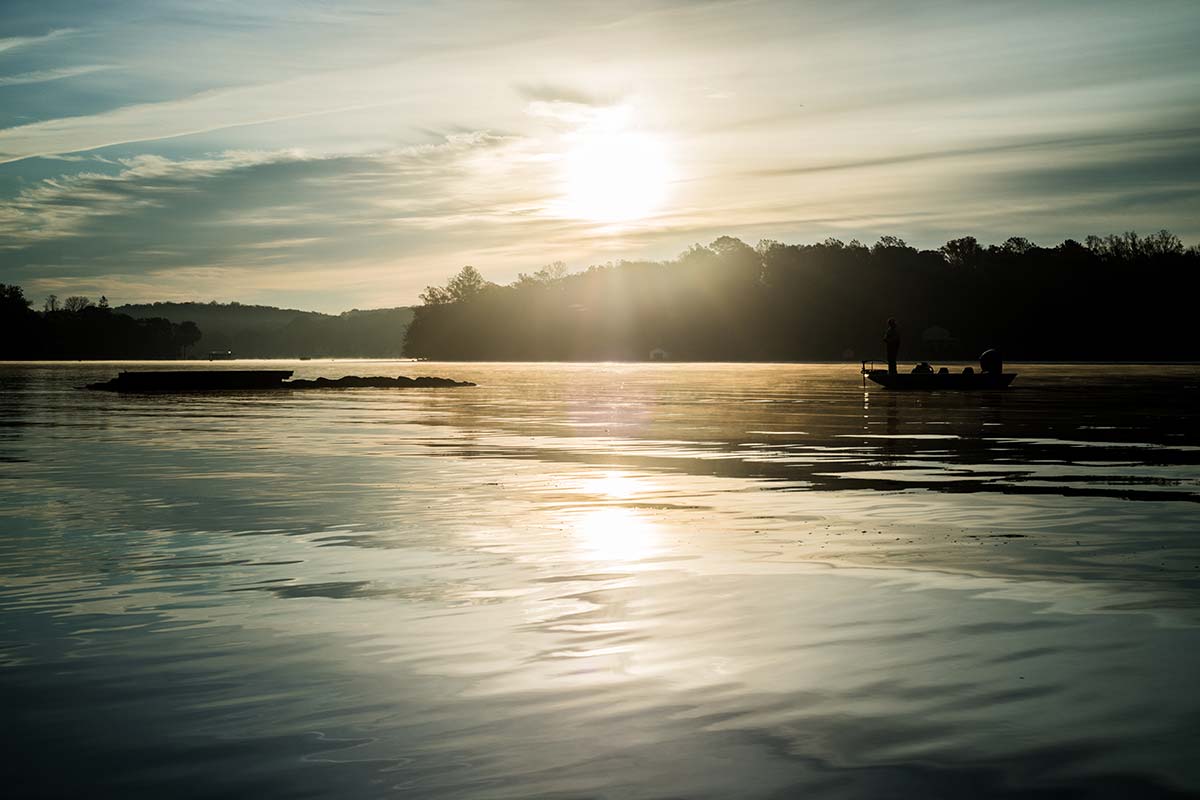
Northwest New Jersey is home to an outstanding walleye fishery; try it, you’ll love it!
“The lake hasn’t turned over yet,” Jim Welsh of Dow’s Boat Rentals said. It was mid-October, when normally Lake Hopatcong is in the process of gathering oxygen from top to bottom. That process is complete when the temperature is about 56 degrees through all depths, nowadays usually by early November.
If I remember Jim saying so, the water temp had been hovering in the upper 60’s. The walleye fishing during off-hours had been miserable.
Mark Licht and I had arrived in the dark before dawn, but despite the bad news, the water had cooled to 63. I reveled in the 40-degree chill of a light breeze as morning edged forward. Standing on the dock in the dark felt enthralling for one reason: I knew the sudden cold meant we would probably catch walleye. The last time temps in the 40s had felt so good, I had just gotten out of a tent while camping during August in Roscoe, New York. I built a fire to boil water. Coffee never tasted better.
Brian Cronk and I had made plans to introduce Mark to walleyes. Though the trees remained green, the sudden cold did prove to be in our favor. Another friend of Brian’s had shot a bear the previous evening, however, and Brian tended to those matters instead of fishing with us. But Mark came fully confident, eager to learn, and in an hour or so of being on the lake, he caught a walleye better than 4 pounds.
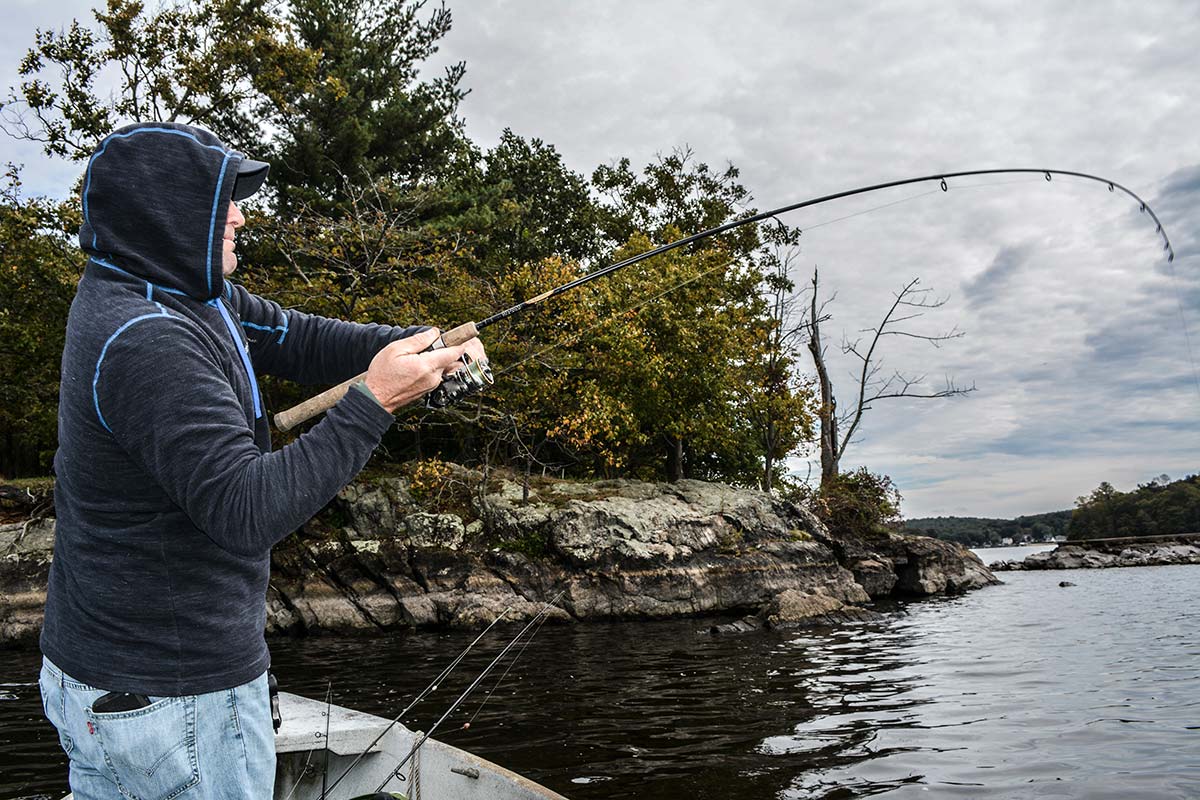
Cold Fronts Are Favorable
Fishermen typically think cold fronts are bad. That’s not a habit of mind exclusively pertaining to largemouth and smallmouth bass, but I can’t think of any two other species popularizing the notion more. They’re warmwater fish, and cold fronts tend to turn them off. Walleyes are cool water fish, though. They don’t have the predilection to the cold as trout and salmon do, but you won’t likely find them in 3 feet of 85-degree water, where you will find largemouths.
A blue sky and bright sunlight, however, typically accompany a cold front. Since walleyes are averse to light, you might think a cold front is not good for them, either. Friends and family and I have, though, caught plenty of October walleyes under cloudless skies, but they’ve all struck in depths greater than 25 feet where it’s plenty dark. On the morning Mark and I fished, we had cloud cover. Fish marked on the graph about 25 feet at deepest. Turnover had only made it about halfway down into the deepest and darkest water. Any deeper, no oxygen had penetrated yet, but only one of our walleyes hit near the bottom line. We did catch walleye later in the morning as shallow as 15 feet or so, which might not have happened if the sky were clear. Not all of the walleye waters in our region suffer anoxic conditions as severely as Hopatcong does, but some form of it seems inevitable in the eutrophic waters where these fish get stocked.
If October temperatures are warm again this fall, let it be a foregone conclusion that the cooler temps of a sudden cold front will favor the fishing on any of the lakes or reservoirs. Although most of us can’t plan on fishing by the weather forecast, if we’re fortunate to meet with favorable chill, it’s best to know that’s the case. We go when our schedules allow, but if there’s any leeway in planning, watch the weather in advance. Even if you just have to get lucky as Mark and I did, the more aware you are of what’s working for you, the more likely your responses will pay off.
Immediately after warm weather isn’t the only time a cold front is productive. We always seem to catch a few in October when the weather’s been on the cool side and turns exceptionally cold. I remember at least one incident when the dock was ice coated. Dew had fallen and then frozen, the temperature rising from 27 to the low 40’s when we left at one or two in the afternoon. Early that day the sky was cloudless, but we caught walleyes.
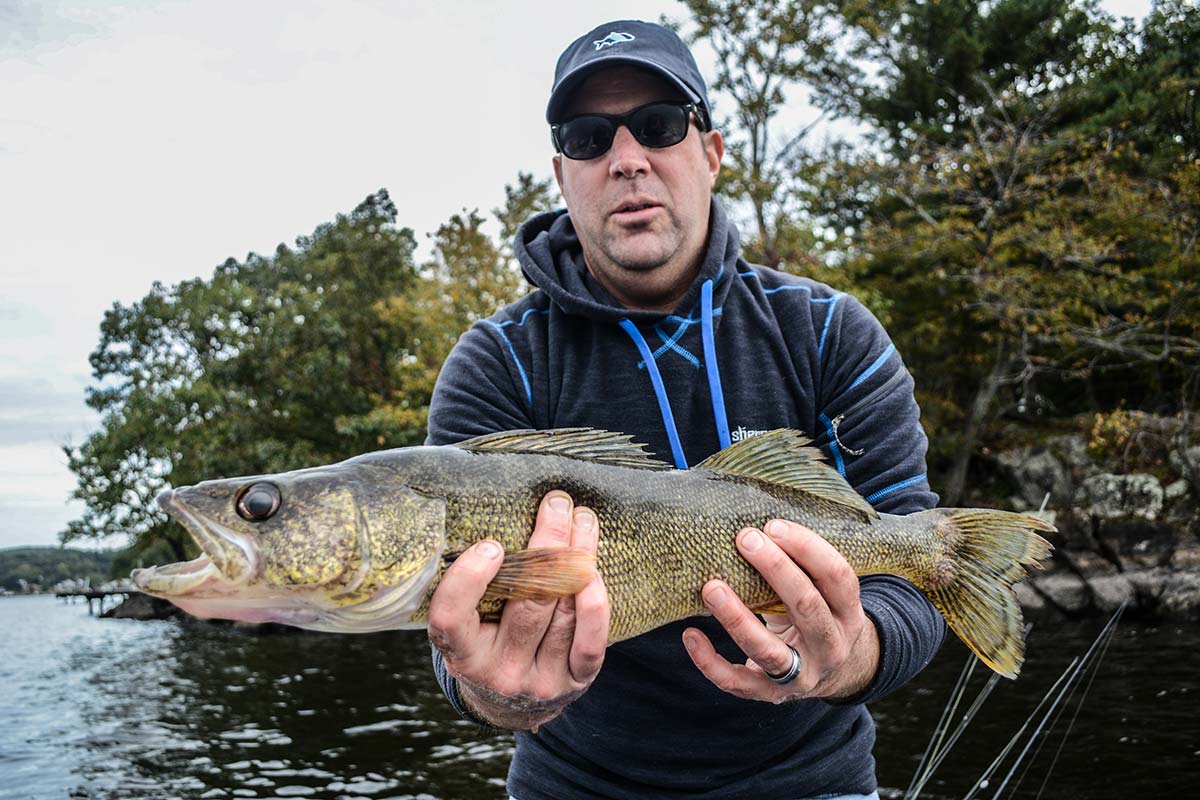
Key In On The Shallows
Anoxic conditions at Hopatcong in mid-October mean relative shallows are opportune, but I wouldn’t be surprised if reservoirs like Monksville, which may not have the problem as severely, offers similar likelihood for success in the shallows. I’ll get to that in a moment. First, during the 1970’s, Spruce Run Reservoir produced trophy rainbow and brown trout that needed cool, oxygenated summer depths. Currently, the reservoir during summertime is anoxic deeper than about 12 feet, from what I understand. It goes to show how quickly the process of eutrophication can unfold. Nutrients, especially nitrogen and phosphorus, feed algae which dies and is consumed by bacteria that eats up oxygen.
I’ve fished walleye in Hopatcong going on two decades now, and I’ve been amazed all along at how they must manage without access to depths greater than about 18 feet during summer. In any event, finding them relatively shallow during October is first and foremost a function of structure, lack of oxygen secondarily. If oxygenated depths fall off rapidly to 50 feet from 12 or 15 feet, I believe some walleye, some of the time, will frequent the shallow end of that drop off, so long as the water temperature remains relatively mild. It shouldn’t matter what lake or reservoir.
They certainly do frequent relative shallows in Hopatcong before deep turnover and the colder water gets me interested in depths of about 30 to 45 feet. Rather than anchoring live herring to the bottom by use of a 3/4-ounce slip sinker, a barrel swivel, and a 5-foot leader, and rather than livelining live herring without weight, I love to cast and retrieve a Binsky bladebait.
Perhaps the classic way to fish one isn’t by jigging vertically as you would a Gotcha or Rapala Ice Jig directly under the boat—usually in 30 feet of water or more—but by casting, letting it sink, and lifting it off bottom so braid line allows you to feel it vibrate and allows you some feel when you let it drop back and the hit often comes. You can take a hint, though, by looking at all the suspended fish on your graph. They’re not all yellow perch. And no walleye will likely drop back and hit a Binsky lifted from bottom only 2 or 3 feet its way.
That’s why I like to limber up and make my retrieve a line of jazz. Anywhere in the water column from about halfway to bottom on down, I try to make every retrieve rhythmic and susceptible as if the Binsky is a herring escaping from a predator, which means I don’t retrieve too fast, though I will make that lure swim. The hit often comes from walleye suspended 6 or 7 feet off the bottom. That bottom may be only 14 feet under the surface.
Last fall, fishing this way earned some respect from me for mid-October. Cast and retrieve, cast and retrieve – it takes effort. But it pays off. That’s not to say seeing the line slowly unwind from a spool while the bail’s open can’t be heart-stopping for you – and the herring – but a Binsky is a piece of metal and plastic. To fish it well and catch big walleyes is closer to art.
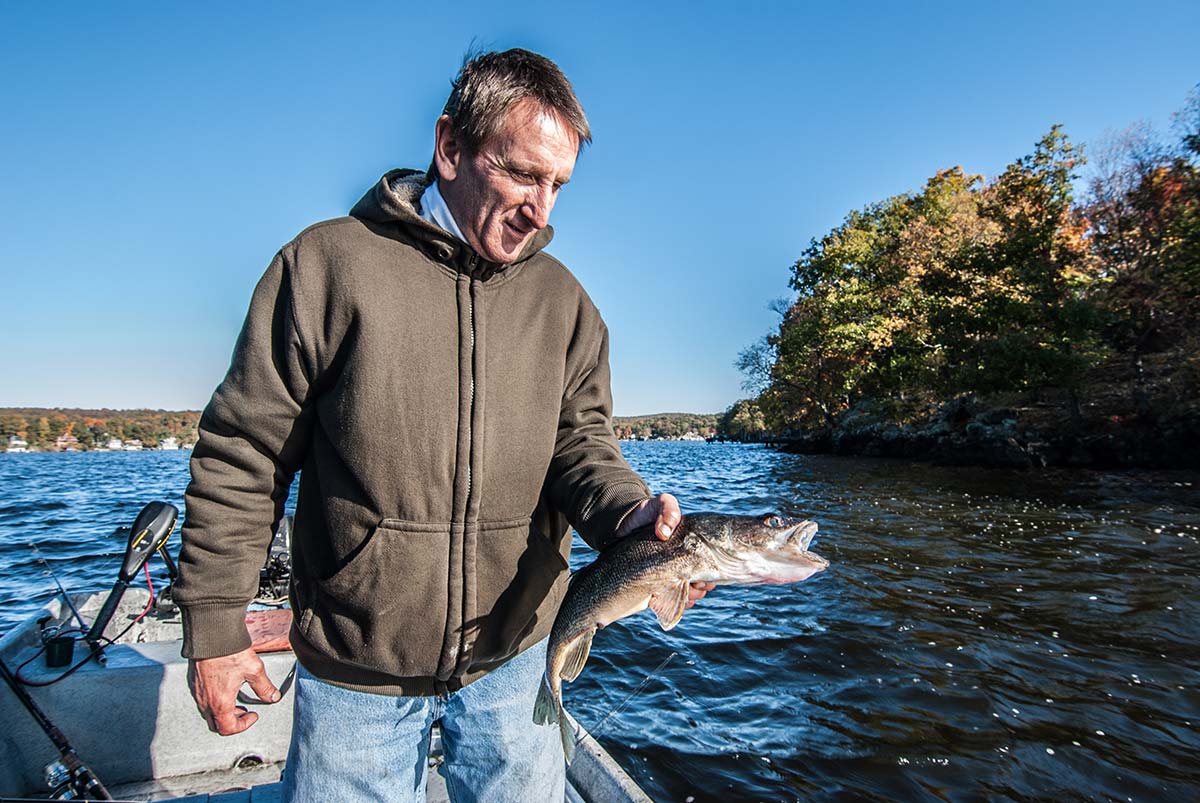
Later In The Fall
After the water temperature falls to 56 and lower, probably in early November, the likelihood clearly seems to lessen to near zero of walleyes actively assaulting a Binky retrieved by a swimming motion. The classic method of slowly working the depths by a lift/drop retrieve works instead, as vertical jigging will also produce on into December and later through the ice. The drop-offs are where the action is, whether you’re fishing in early October or early January, but colder water means fish less interested in following a drop up to the shallow end of it. Place your bets wisely by fishing the deep end.
Every drop-off has an edge on the deep side. Beyond that, a flat. If you drift away from the edge and over the flat, most likely you’ll mark fish on the graph, but by fishing the structure – particularly the not-so-straight line where the drop-off begins to rise – you might do better than fishing just anywhere out there. The irregular bottom features of a lake or reservoir – structure – tend to attract both baitfish and predators. If you’re not convinced, position your fishfinder over a drop-off and see for yourself. You’ll certainly see fish there, and to fish the bottom edge, I believe, will make the best of your time when the water is cold. Besides, if you were to catch only one of a hundred fish you mark, you would fill the boat. Nothing would be more frustrating than depending too much on a fishfinder. Keep your Binsky, Gotcha, or Ice Jig on structure, and watch your line more than the graph.
Whether you retrieve a Binksy, jig vertically, or set live herring might be a matter of how windy it is and what sort of boat you have. A powerful bow-mounted electric makes vertical jigging in heavy wind possible if a pitching boat is not too unsteady. You can cast a Binsky instead, if that’s your preference. Walleye below often tend to be active, as if the commotion above them – often caused by a cold front – loosens inhibitions. It’s not just a matter of wavy surface reducing light penetration.
